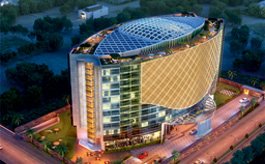A product warehouse building was conceptualized by ONGC Petro additions Limited (OPaL) and Engineers India Ltd (EIL) for IOT Infra to cater requirement of product handling and storage of OPaL’s Petrochemical Complex. Built at Dahej, Gujarat this is a 1-km long and 135m wide structure covering an area of 1,40,000 sq. mtrs. The complete work of product warehouse including pre engineered building was awarded as LSTK job to joint venture of Katoen Natie and IOT Infrastructure based on International Competitive Bidding (ICB). PEBS Pennar was selected by IOT Infrastructure for design, fabrication and installation of pre engineered building of product warehouse, which was accomplished with peak manpower of 250 workers and approximately 9.2 lac safe man-hours.
Project Brief
With a simple brief given to design the state-of-the-art product warehouse with flexibility to select bagging machines vis-a-vis silos, and to have maximum possible storage space, the building is designed with unsymmetrical frames. The silo frames are the mainstay of the structure with rafters resting on the RCC building. The building is the widest multigable building ever done by Pennar. Designing of the structure was done using continuous jack portal; where 24m jack beam was used as the portal to make column-less space inside the building, as the customer required free end space of 135m by 24m along the length of the building.
The complete design is vetted by EIL, which gave the approval for the design after being satisfied with the codes and the design methodology adopted. Star columns are used at each expansion joint in order to maintain portal stability and economics in longitudinal and transverse direction. In addition to space restriction, the clear height had to be maintained along valley time to facilitate the movement of machineries and vehicles. The entire building is installed with Double Lok roofing system which ensures 10 years of leak proof warranty.
Structural Elements
The basic structural system consisted of main frames with secondary members provided between these frames for sheeting support. The columns and rafters of the building are of varying web depth, with a maximum web depth of 1000mm. The rafters are resting on jack beams at the interior of the building. These jack beams span across 24m and were for full length of the building at five locations wherein the maximum web depth of the jack beam was 1400m. The secondary members are cold formed “Z” or “C” sections varying in thickness and having maximum thickness of 2.5mm.
Structurally Exclusive
The project is a unique and challenge in respect to both, designing as well as installation. There was no such reference which made the entire design to be contesting. Stability was the major concern with collateral load of dust, wind speed and seismic load. The entire team of engineers toiled hard for the approval of the project.
Fabrication and transportation of huge structures was an exceptionally arduous task as it was not possible to carry out welding onsite. Apart from this, the biggest challenge was to gather and maintain a huge task force of skilled workers together and maintain the momentum at project site. Despite several challenges and constraints, the team at Pennar accomplished the project successfully with the best of its quality and time.
Steel Specifics
Considering the application of steel in the realm of pre engineered building and ease of usability, steel was selected as the material of choice. This impressive structure was instituted using multiple deployments of resources and was erected from different expansion joints and by connecting the junctions. The built-up “I” sections and jack beams were fabricated from plates of ASTM with minimum yield strength of 345 mpa. These built-up “I” sections were fabricated with flange to web fillet welding which was carried out in a continuous submerged arc welding machine. The end plates/gusset plates etc. were joined by continuous fillet welding manually. The secondary members were from ASTM A 653m with minimum yield strength of 345mpa. Other hot rolled sections used such as angles/rods etc. were of I.S 2062 with minimum yield strength of 240 mpa.
Challenges
The biggest challenge for this project was the huge volume in terms of area of work. During conceptualization and design stage, the challenges were cost optimization and minimum construction time. The sheer size of the structure proved a challenge even when it came to deploying multiple teams and resources. The limited timeline of 8 months was yet another area that contributed to the difficulties faced by the team. The manpower used in the project was in proportion to the size and mobilizing sufficient manpower while working overtime was a major contributor to the list of difficulties which were overcome by the team of qualified professionals at hand.
Safety First
For a project of this size, it is absolutely essential to have the safety regulations down to a pat. The project saw safety screening of deployed manpower, imparting onsite safety training, job safety analysis of individual work methods, safety gears like full body harness for workers on height, using safe access methods like boomlifts, man-basket etc. in order to successfully and safely complete erection of the design.





